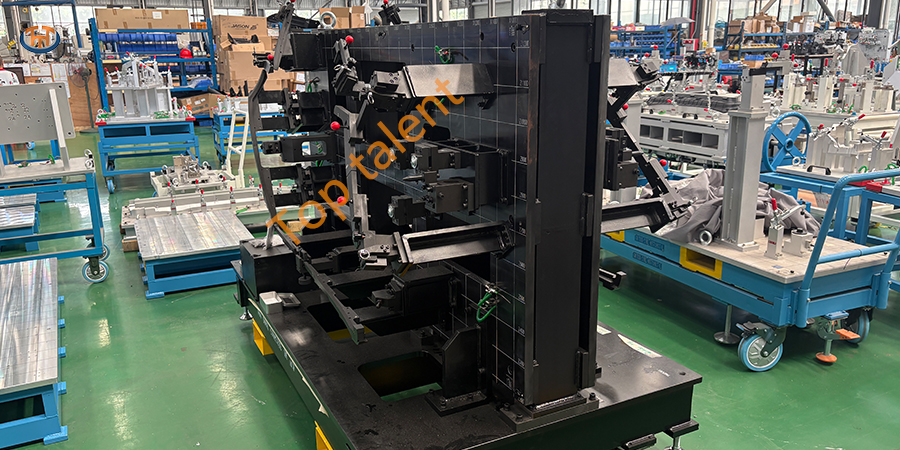In the high-stakes world of automotive manufacturing, where safety, performance, and aesthetics collide, plastic components are no longer just trim pieces. They are intricate structural elements, complex housings, and critical interior/exterior parts. Ensuring these plastic parts meet exacting specifications is paramount. Enter the unsung hero of quality control: the automotive plastic parts checking fixture.
What Exactly is a Checking Fixture?
Think of it as a physical “gold standard” for a specific plastic part. It’s a custom-built, rigid structure, typically crafted from dimensionally stable materials like aluminum, steel, or advanced composites, that precisely replicates the critical geometry and mounting points of the final vehicle assembly. The part in question is mounted onto the fixture, allowing inspectors to quickly and accurately verify:
Dimensional Accuracy: Does the part match the CAD model within the tight tolerances demanded (often measured in fractions of a millimeter)?
Form & Contour: Does the complex curvature and shape align perfectly with the design?
Hole & Feature Location: Are all mounting holes, clips, slots, and functional features exactly where they should be?
Assembly Compatibility: Does the part fit correctly with its mating components (simulated on the fixture)?
Why are Checking Fixtures Non-Negotiable for Plastic Parts?
Speed & Efficiency: Manual measurement with CMMs or hand tools is slow and impractical for high-volume production. Fixtures enable rapid “go/no-go” checks directly on the shop floor, often in seconds per part. This accelerates inspection throughput and keeps production lines moving.
Unmatched Accuracy & Repeatability: Properly designed and built fixtures eliminate human measurement error and provide consistent, reliable results shift after shift. They are calibrated to master standards, ensuring traceability.
Complex Geometry Handling: Plastic parts often feature intricate 3D shapes, undercuts, and complex surfaces difficult to measure conventionally. Fixtures physically conform to these shapes, making validation intuitive.
Early Defect Detection: Used during tool try-outs (TT), pre-production runs, and incoming part inspection, fixtures catch dimensional flaws before parts reach assembly. This prevents costly rework, scrap, and potential line stoppages.
Rigorous Standards Compliance: Automotive manufacturing demands adherence to strict standards like GD&T (Geometric Dimensioning and Tolerancing). Fixtures are designed using these principles, ensuring parts meet the functional requirements defined by engineering.
Supplier Quality Assurance: OEMs and Tier 1 suppliers use fixtures to validate parts from their suppliers, ensuring consistency across the supply chain.
The Anatomy of a Modern Fixture
Today’s fixtures are sophisticated tools. Key elements include:
Base Frame: Provides rigidity and stability.
Locators: Precision pins and surfaces that position the part consistently in its correct datum reference frame.
Clamps: Secure the part firmly without inducing stress or distortion.
Check Points/Gauges: Dial indicators, feeler gauges, gap gauges, or electronic probes measure deviations at critical features defined in the part’s inspection plan (GD&T).
Simulators: Represent mating components to verify assembly fit.
Materials: Aluminum is popular for its lightness and machinability. Steel offers extreme durability. Composites provide stability and lightness.
Beyond Metal: The Future of Fixturing
While traditional metal fixtures dominate, advancements like 3D printing (Additive Manufacturing) are making inroads, especially for low-volume production, prototype validation, or complex internal features. Printed fixtures can be faster and cheaper to produce for certain applications, though material stability and long-term durability are still evolving compared to metal.
Investing in Precision Pays Dividends
For automotive manufacturers and suppliers, robust plastic parts checking fixtures are not an expense; they are a critical investment in quality, efficiency, and brand reputation. They are the physical guardians ensuring that every bumper, console, duct, lamp housing, and intricate clip fits perfectly, functions flawlessly, and contributes to the overall integrity and appeal of the vehicle. In an industry where precision is paramount, the checking fixture remains an indispensable tool for achieving excellence in plastic component manufacturing.
Post time: Aug-08-2025



.png)
.png)